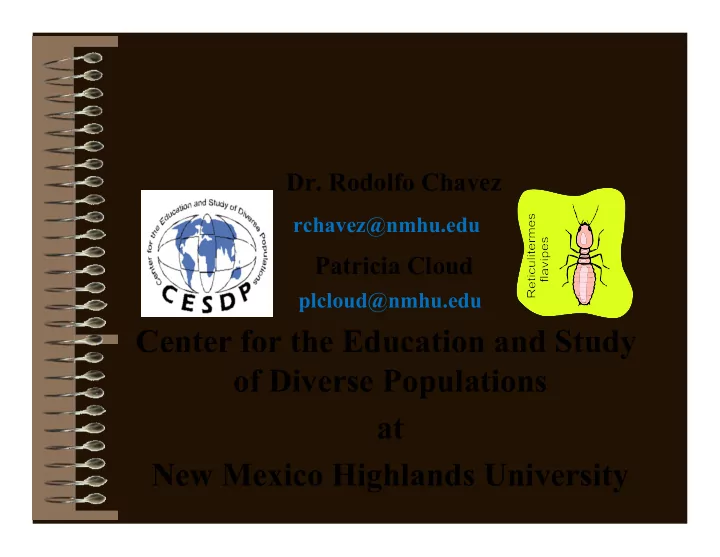

Termites Catch the Scent! Dr. Rodolfo Chavez rchavez@nmhu.edu Patricia Cloud plcloud@nmhu.edu Center for the Education and Study of Diverse Populations at New Mexico Highlands University
What do you know about termites?
What do you know about odors and animals?
1. Using the trail sheet, trace the 4 lines using a marker, Bic pen, colored pencil, and crayon. 2. Holding the cup close to the paper, brush termites onto the paper. 3. Place them close to the beginning of each line. Observe their behavior and record it on the data sheet. 4. When complete, brush the termites back into the cup.
Unit Plan What NM Science Content Standards will be addressed in this unit? What Common Core State Standards will be addressed in this unit? What English Language Proficiency Standards will be used in this unit? What big idea will be established in this unit? What essential question will guide this unit? What teaching model will be used?
What Academic Language will be focused on? What will students be able to do by using this standard? How will student progress be monitored? What culminating measure will we use to determine students’ overall achievement of the skills?
NM Science Content Standard for Grade Six Standard I: Understand the processes of scientific investigations and use inquiry and scientific ways of observing, experimenting, predicting, and validating to think critically. 5-8 Benchmark I: Use scientific methods to develop questions, design and conduct experiments using appropriate technologies, analyze and evaluate results, make predictions, and communicate findings.
Student Friendly Standard I will be able to observe what happens while doing this experiment. I will discuss what happens with my partner. I will be able to make predictions about what I observed by seeing patterns and relationships. I will write down what I observe.
Common Core State Standard Reading Standard used for Literacy in Grade Six Science: • Cite specific textual evidence to support analysis of science experiment. • Compare and contrast the information gained from the experiment with that gained from reading the text.
ELD Standards (Listening) Level 1: (Entering) Share real life examples of what you already know about termites. Level 2: (Emerging) Listen to a description of termites with a partner/teacher. Level 3: (Developing) Build a hypotheses from oral description with partner. Level 4: (Expanding) Follow multi-step directions with some technical language to text hypothesis. Level 5: (Bridging) Draw conclusions regarding results of investigation.
ELD Standards (Speaking) Level 1: (Entering) Create and present orally depictions of termites. Level 2: (Emerging) Brainstorm ideas and share orally about what might happen. Level 3: (Developing) Predict what may happen based on visual images. Level 4: (Expanding) Analyze and identify reasons for what happens. Level 5: (Bridging) Evaluate theories and practices relate to what happens.
ELD Standards (Reading) Level 1: (Entering) Match pictures with words. Level 2: (Emerging) Sort pictures and phrases into categories. Level 3: (Developing) Predict traits of termites based on visually supported text. Level 4: (Expanding) Analyze and identify reason for termite behavior based on experiment and text. Level 5: (Bridging) Evaluate theories based on termite behavior.
ELD Standards (Writing) Level 1: (Entering) Answer “What”, “How” and “Why” questions based on drawings, words and phrases. Level 2: (Emerging) Answer questions using phrases and sentences. Level 3: (Developing) Complete lab report following step-by-step procedures in text. Level 4: (Expanding) Produce a lab report using learning log. Level 5: (Bridging) Create a narrative lab report.
Big Idea Some insects communicate through chemicals know as pheromones. The odor is unique to individual colonies and is there to help recognize each other, alarm to support attack, and to follow new food sources.
Teaching/Learning Model Inquiry Learning: Teaches students how to learn Teaches substance Teaches how to collect raw data Teaches discovery
Why is inquiry learning good for Language Learners?
Essential Question How can knowing about the pheromones of termites help me understand my environment?
What Academic Language will be focused on? What will students be able to do? How will student progress be monitored? What culminating measure will we use to determine students’ overall achievement of the skills?
symbiotic protozoa pheromone workers odor soldiers adult reproductives nymph castes egg ecosystems metamorphosis recycling insect features termites six legs abdomen thorax head
Recommend
More recommend